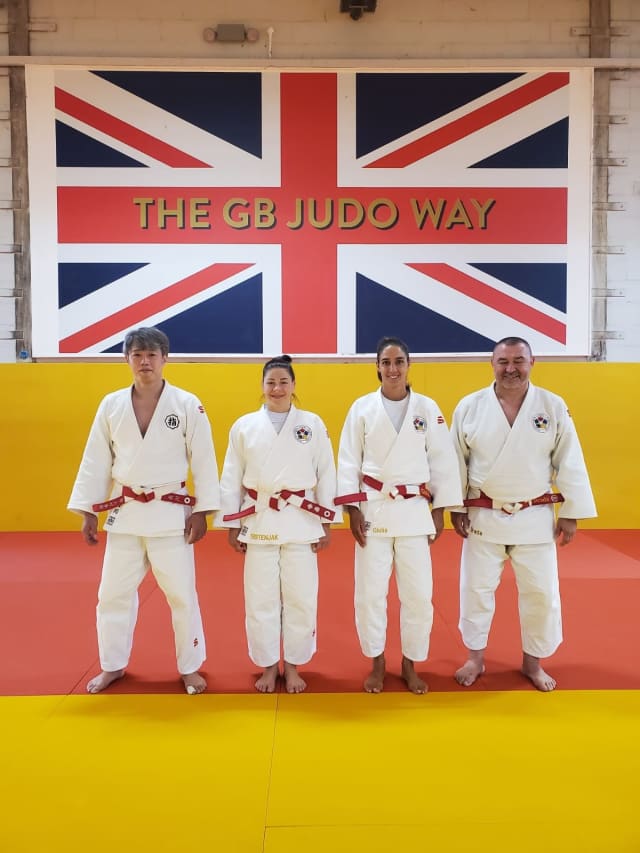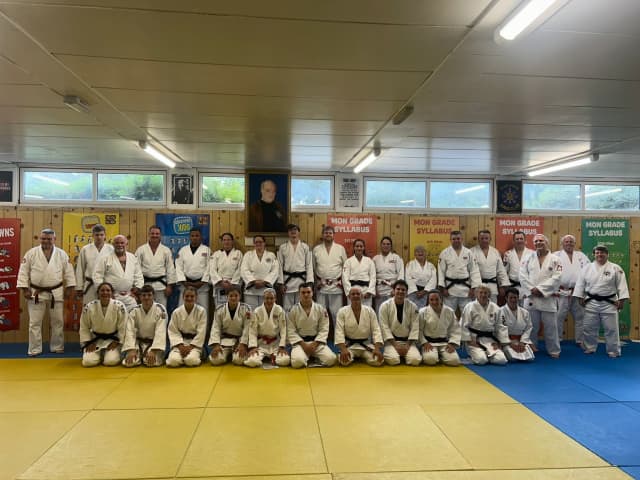With her competitive days behind her, Karen seeks new challenges to force evolution and learning, on a constant basis. To that end, this week she competed at the World Kata Championships in Paris, having never competed in kata at any level before. Karen, a 7th dan, was tori for Itsutsu-no-kata with her uke Fiona Chan, an active competitor on the European and world veteran circuits.
“After the competition, Karen posted on social media, “This was a very purposeful experience in my role as Development Director but what a day, what an experience! From a judo perspective, this has opened up a whole new aspect of judo to explore. On a human level, it’s been about taking on new challenges and commiting to them. The big bonus was the partnership we developed to perform; this is like no other judo experience! Thank you Fiona!!”
Prior to heading out to Paris though, Karen was already very much in deep thought and spoke with the IJF Media Team about the many ideas spinning in her head, “How can I use my Itsutsu-no-kata story to promote kata? It’s odd to talk about my background as it had absolutely nothing to do with kata but I now find that it is a huge part of why I am here, why I am doing this. I want to use my experience to create something that opens possibility, taking away the fear of not knowing enough and the preconceptions around kata among some in the judo world. We can all thrive through the act of learning, no matter the subject matter but when it’s a whole new volume of the judo encyclopaedia, it somehow becomes compelling.
I have been inspired throughout my career in so many ways and by so many people. I watched Izzie Everest and her partner Braydon Robus perform an adaptive version of Nage-no-kata at the British Championships. Izzie has cerebral palsy and doesn’t let it limit her in any way. Judo is just one of many activities she is driven to achieve in. She impresses me so much.
I completed the IJF Academy UCJI course in 2023, another period of accelerated learning, of course including learning and understanding Nage-no-kata better than I ever have before. It was so inspiring to have Olympic champions and academic judo researchers teaching us the kata, a complete crossover.
I have also attended several kata courses recently, covering several different forms and levels. It’s been so different from the environments most synonymous with high level shiai and randori where there needs to be a similar level among most participants in order for the progress to be made and the wins to be logged. In the kata courses, all ages, grades and levels are welcome. Everyone learns together and everyone celebrates when anyone makes progress. It feels so much like everyone is making a contribution to that tiny course-based society, perhaps in a way that would have pleased Jigoro Kano.
My background is truly a story of shiai. I was raised at Pinewood Judo Club in the south of England by an incredible coach, the late and great Mr Don Werner (8th dan) and there were many of us: European champion Lynn Tilley, world champion and Olympic silver medallist Nicola Fairbrother, Olympian brother and sister Ben and Megan Fletcher, and many more. Our judo life was one of great immunity, hard training, competition and travel. It was a magnificent life but did not involve even a whiff of kata. To come to this point from that beginning feels so much more exciting than I expected it to and I think that has a lot to do with having a new source of education but still within the sport I love.
I have spent a lot of time over the last few weeks thinking about how Itsutso-no-kata is directly linked to my non-kata background. I studied the Kodokan video, especially the stories behind each technique and reflected on that, really connecting those principles with the reactions used in shiai”
Karen summarised her thoughts around the links between Itsutsu-no-kata and shiai:
-first technique: the constant application of a smalll force. That was a principle I applied ne-waza and won with it without understanding that idea in this way.
-second technique: like moving out of the way to help uke on their way; the idea of kaeshi-waza.
-third technique: like the forces of all rotating techniques.
-fourth technique: any combination forward to back, the power of changing direction.
-fifth technique: again the principles of kaeshi-waza. I particularly related this to an opponent throwing a strong grip, giving tori / me the right moment and some to drop under with a seoi-otoshi or other technique. This was my forté in competition.

“Exploring kata has further expanded my understanding of judo but as is so often the case when open to new ideas, the more we realise how little we know. My new mission is to keep exploring kata for myself but also to provide a springboard to encourage others to jump into it too. Judo is a vehicle for education and we must embrace that in its biggest and most radical senses.”




